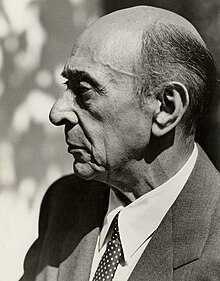
Back Arnold Schoenberg Afrikaans Arnold Schönberg ALS أرنولد شوينبيرج Arabic ارنولد شوينبيرج ARZ Arnold Schönberg AST Arnold Şönberq Azerbaijani Арнольд Шонберг Byelorussian Арнолд Шьонберг Bulgarian Arnold Schönberg Catalan Arnold Schoenberg CEB
Arnold Schoenberg | |
|---|---|
 Schoenberg in Los Angeles, c. 1948 | |
| Born | 13 September 1874 |
| Died | 13 July 1951 (aged 76) |
| Occupations |
|
| Known for | Second Viennese School |
| Works | List of compositions |
Arnold Schoenberg or Schönberg (/ˈʃɜːrnbɜːrɡ/, US also /ˈʃoʊn-/; German: [ˈʃøːnbɛɐ̯k] ⓘ; 13 September 1874 – 13 July 1951) was an Austrian-American composer, music theorist, painter, teacher, and writer. Among the most influential and innovative composers of the 20th century, he was the central figure of the Second Viennese School. His formative early career was mostly in Vienna, though he explored Berlin, moving there in the 1920s. Ousted by Nazis in the 1930s, who proscribed his (and his students') music as "degenerate",[1][2] he settled in Los Angeles.
Schoenberg melded the then opposed German Romantic styles of Brahms and Wagner, coining the term developing variation. He was among the first modernist composers to write music of dense motivic relations penetrating well beyond the musical surface in unified fields. His 1908 String Quartet No. 2 is famed for its atonality. His style as both a painter and composer was expressionist, for example in Pierrot lunaire and Erwartung. In the 1920s Schoenberg arrived at twelve-tone technique, which he substantially developed in music systematically interrelating all notes of the chromatic scale, often exploiting combinatorial hexachords. Confronting popular antisemitism, he returned to Judaism, embracing Zionism and working on Die Jakobsleiter and Moses und Aron. His twelve-tone music did not always eschew tonal inflection; his Suite, Op. 29 features consonances and tonal melody.
Dismissed from the Prussian Academy of Arts (1933), he emigrated, teaching at Boston's Malkin Conservatory. Then he taught at the University of Southern California and as faculty at the University of California, Los Angeles, where facilities are named in his honor, becoming a US citizen (1941). He explored writing film music, as he had done idiosyncratically in Begleitungsmusik zu einer Lichtspielscene, and wrote more tonal music. Taking aim at Hitler in Ode to Napoleon (after Byron), he drew on Beethoven's fate motif and the Marseillaise. His Survivor from Warsaw memorialized Holocaust victims. Theodor Körner beckoned him with honorary citizenship (1946), but Schoenberg was ill as depicted in his String Trio. The Israel Conservatory and Academy of Music elected him honorary president (1951).
At least three generations of composers extended his music's somewhat formalized harmony and rigorous development. Many were passionately against it. Among his students in Europe were Alban Berg, Anton Webern, Hanns Eisler, Egon Wellesz, and Nikos Skalkottas; in the US, John Cage, Lou Harrison, Earl Kim, Robert Gerhard, Leon Kirchner, Dika Newlin, and Oscar Levant. His aesthetic and music-historical views influenced musicologists Theodor W. Adorno and Carl Dahlhaus, as well as pianists Charles Rosen, Artur Schnabel, Rudolf Serkin, Eduard Steuermann, and Glenn Gould. The Arnold Schönberg Center collects his archival legacy.
© MMXXIII Rich X Search. We shall prevail. All rights reserved. Rich X Search